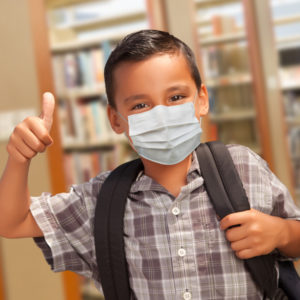
In-person learning and classroom safety remain priorities as students prepare to return to school. Proper implementation of layered COVID-19 mitigation strategies support these priorities.
Vaccines and masks are among the most important and widely available tools to keep classrooms safe.
“Staying up to date on COVID-19 vaccination is the single most important strategy for preventing severe disease from COVID-19,” said State Epidemiologist Dr. Sarah Kemble.
All school-age children are eligible for COVID-19 vaccines.
An estimated 78% students ages 12 to 17 years old have completed their primary series of two vaccinations and 26% of them have received a booster shot.
An estimated 40% of children ages five through 11 have completed their primary series but only 4% have received a booster shot.
“Hawai‘i’s vaccination rate is well ahead of the national average, but more young children could benefit from getting their shots. We encourage those who haven’t been vaccinated to get their primary series of shots and those who have already received their primary series to get their boosters,” Kemble said.
Masking continues to be an effective tool in reducing transmission of SARS-CoV-2, the virus that causes COVID-19.
The Department of Health’s revised Guidance for K-12 Schools strongly encourages indoor masking when COVID-19 Community Levels are medium or high. However, effective Aug. 1, the DOH guidance no longer recommends universal indoor masking at schools.
“Masks are a good idea,” Kemble said. “They are especially important for families with children who are vulnerable because they haven’t been vaccinated or because they have an underlying health condition. Children who wear masks at school will not only be protecting themselves. They will be protecting their parents and grandparents who are at higher risk of severe illness from COVID-19.”
The Guidance for K-12 Schools recommends universal or targeted indoor masking in certain settings such as a particular class or grade level when specific situations occur such as a cluster of cases, an outbreak, or high absenteeism.
The Guidance for K-12 Schools also covers the importance of ventilation, COVID-19 testing, and staying home when sick.
“The revised guidance represents a move toward a new normal. It is made possible by the widespread availability of COVID-19 vaccines for everyone six-months and older, high levels of infection-induced and vaccine-induced immunity, increased access to testing, effective treatments, and lower rates of admissions to hospital intensive care units,” Kemble said.
The revised guidance is based on the current situation. It may be adjusted if there is a significant change in disease transmission patterns and case severity.
Denby Fawcett: Why So Few People Are Getting The New Covid Shot
Experts are worried about the lack of interest as people are still suffering from the virus and long Covid. By Denby Fawcett Original article on Civil Beat, November 7, 2023 I keep a card in my [...]
Federal Public Health Emergency (PHE) for COVID-19 ends on May 11, 2023
HONOLULU, HI –The federal Public Health Emergency (PHE) for COVID-19, declared under Section 319 of the Public Health Service Act, will expire at the end of the day on May 11, 2023. As the PHE [...]
Seniors now eligible for additional COVID-19 bivalent booster dose, COVID vaccine recommendations simplified
HONOLULU, HI – The Hawai‘i Department of Health (DOH) supports the latest recommendations announced yesterday by the Centers for Disease Control and Prevention (CDC), allowing an additional dose of the bivalent booster against the virus [...]
Hawai‘i COVID-19 hospitalizations on the rise
HONOLULU, HI – The Hawai‘i Department of Health (DOH) reports a rise in the rate of COVID-19 hospitalizations. The number of total positive COVID-19 hospitalizations has increased over the past week (3/26 – 4/4) from [...]
Wastewater Samples Show Higher COVID Concentrations & New Subvariant
The Hawai‘i State Department of Health’s most recent Wastewater Surveillance Report documents two significant developments about COVID-19 in Hawai‛i. Higher concentrations of the virus that causes COVID-19 The arrival of the XBB.1.5 subvariant Higher concentrations [...]
Bivalent boosters for keiki as young as 6 months
Updated COVID-19 bivalent boosters are now available in all counties for keiki as young as six months of age. The U.S. Food and Drug Administration (FDA) amended the emergency use authorization for the bivalent boosters [...]
